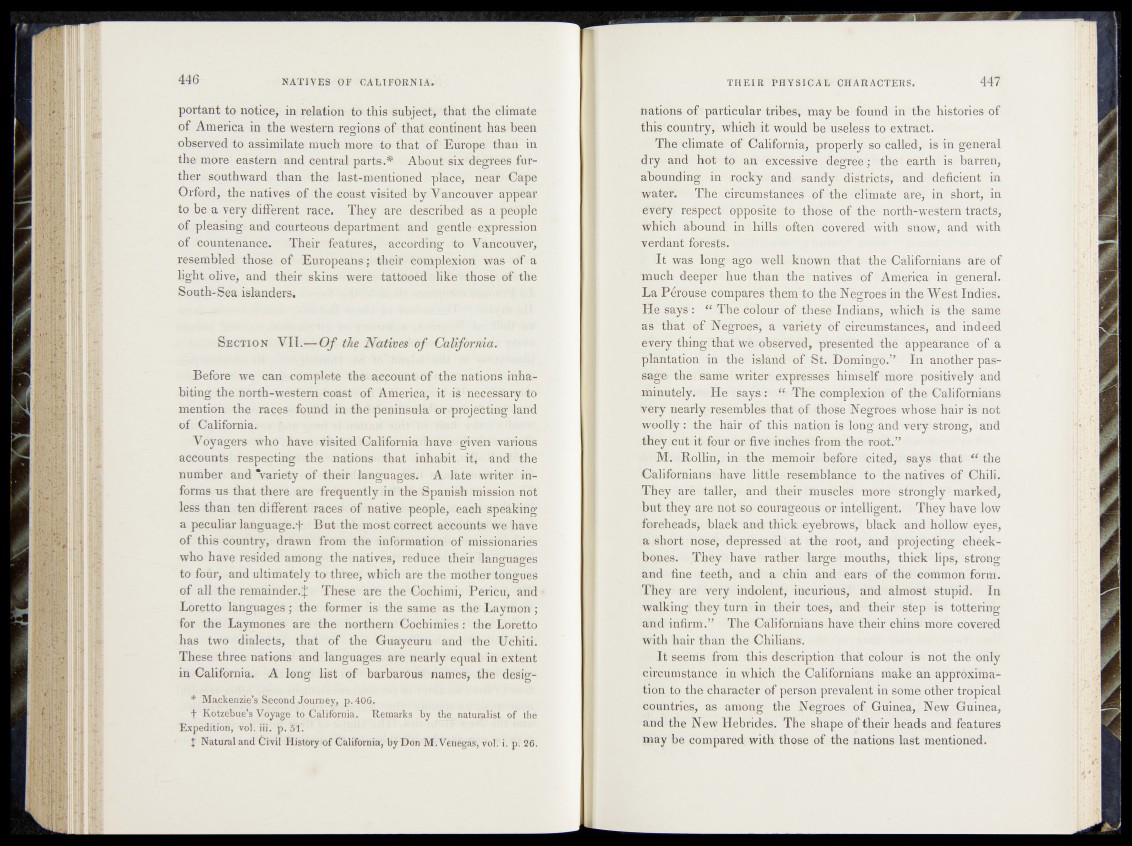
portant to notice, in relation to' this subject; that the climate
of America in the western regions of that continent has been
observed to assimilate-much more to that of -Europe than in
the more eastern and central parts-;* About sixdegtees further
southward than the last-mentioned pJa.ee/ near Gape
Orford, the natives of the coast •visited-by Vancouver' appear
to be a very different race. They are described as a peopM
of pleasing and courteous department and gentle’ expression
of countenance. Their features, according to Vancouver,
resembled those of Europeans^ »their completion was df a
light ofive, and -their skins »were tattooed hMe «those ©ftthe
South-Sea islanders.
Section V II.— O f the Natives o f Califo rm a .
Before we can complete the- g^coun€ :of 4hématioöS lnba^
biting the north-western coast of America,; it #meee8S&iyvitO
mention the races found in the: peninsula ©r projedting land
of California.
Voyagers who have visited California rfhavet^Wèn svarious
accounts respecting! the nations that inhaMturoiy H n # iill
number and "variety of their language^;! A late* write®!informs
us that there are frequently in the Spanish mission nét
less than ten different races of native people, "each speaking
a peculiar language.*!' But the roost correct aècóunts- we havb
of this country, drawn from the information’ofomisslèndfies
who have resided among the natives;: reduce their «languages
to four, and ultimately to three, which are the mother tongues
of all the remainder.J These are the Coehimi, Pericu, and
Loretto languages; the former is the same as the Laymon ;
for the Laymones are the northern Cochimies: the Loretto
has two dialects, that of the Guaycuru and the Uchiti.
These three nations and languages are nearly equal in extent
in California. A long list of barbarous names, the desig*
Mackenzie’s Second.Journey, p.406,
f Kotzebue’s VÖyage to .California, Remarks by the, naturalist of the
Ex|»edidó#,r'Vot. iii. p. 8¥?
t Natural and Civil Histoty of California, by Don M.Venegas; vol. i. p; 26.
nations of^particular tribes, may be found in the histories of
this- country, which it would'be useless to extractXM
*r The* climate of California; properly • so called, is in general
dry add ..-hot to anexe'essive > degree; the earth is barren,
abounding in rocky and> sandy! districts/ 1 and ’deficient in
wafer* The’ eircumsty&ces -.'of the’dfiiinate are, in short, in
every respect oppositevito t'b©se of tbeif north-western tracts,
which al^ound in < hilllp often fiebifefed1 with snow, and with
.verdant- forests.
It was long”ago »well known that- ’tbe?<Califorhians are of
'much deeper -Hue »than .thei*’®ajtives of America iri'<gerferal.
LaP&rouse compares them to the Negfoes^in the West Indies.
He says : “ The colour of tMeSS Indians, which is^the same
as th a t‘of Negtofes, a varfetyfef circumstances, and indeed
every thing’bhat WAobserved, pTfes^ted life appearance of a
plantation in the island of St. Doming©.- In another pas-
thersamei write»^-expresses himselfcaMore positively and
minufelyiV He says):; “ The complexion; of the Californians
iviny nearly resembles tbatfof those Negfoeswhosbhair is not
-woolly: the hair of this nation is long and very strong, and
-iftfey?out itj four'onifive» inchesifrom the root. ’bm
M. Roll-in,i in the memoir beforoi'cited, ^‘says that “ the
Galiferniansnhave little resemblance to the natives of' Chili.
They are tsiilier; and their musetes mprC*!;s#ongly marked,
but they are not so courageous- or intelligenti*p They have low
foreheads, black and thick eyebrows, black and hollow eyes,
a short nose; depressed) s at the root, and projecting cheekbones.
They have rather large mouths, thick lips; strong
and fine teeth, and a chin and ears of the common form.
They’ are very indolent; incurious,' and almost *'8&ipid. In
walking? they turn in their toes; and their step: is tottering
and infirm.” TheiQbbfotmhte?haveHheir chins more covered
with hair than the Chilians.
It seems from this description that colour is not the only
circumstance in which the Californiansft make an approximation
to the character of person prevalent in some other tropical
countries, as among the Negroes of Guinea, New Guinea,
and the New Hebrides. The shape of their heads and features
may be compared with those of the nations last mentioned.